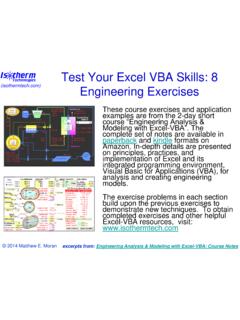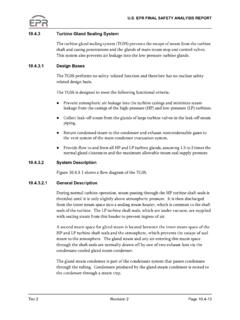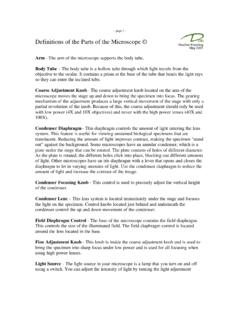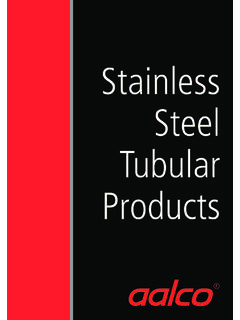Transcription of Introduction to Heat Pipes - NASA
1 Introduction to heat PipesJentung KuNASA/ Goddard Space Flight CenterGSFC 2015 Outline Introduction heat pipe Operating Principles Pressure DropsPressure Drops Operating Temperature Functional Types of heat Pipes heat pipe Operating Characteristics heat pipe Design and Selection Design Considerations (mostly for Vendors)g(y) Selecting heat Pipes as Part of Thermal Control System and Modeling of heat Pipes (for Thermal Analysts) Some Practical ConsiderationsSome Practical Considerations Some Examples of Flight Applications Other Types of heat Pipes2 Introduction to heat Pipes - Ku 2015 TFAWSHeat Pipes - HardwareM t l ( li) t bithth ifldti Metal (aluminum) tube with grooves on the inner surface cold extrusion Grooves are filled with the working fluid (water, ammonia, propylene, etc.)
2 Flanges can be added on the outer surface for easy integration with instruments or radiators (The flange is an integral part of the extrusion)3or radiators (The flange is an integral part of the extrusion) Various diameters, lengths, and groove sizesIntroduction to heat Pipes - Ku 2015 TFAWSI ntroduction Why heat Pipes ? heat pipe is a capillary two-phase heat transfer device. Transports heat from a heat source to a heat sink Works as an isothermalizer Why two-phase thermal system? Efficient heat transfer boiling and condensationEfficient heat transfer boiling and condensation Small temperature difference between the heat source and heat sink Why capillary two-phase system?
3 Passive no external pumping power Slfltiflt l d i Self regulating no flow control devices No moving parts vibration free4 Introduction to heat Pipes - Ku 2015 TFAWSHeat Pipes Operating PrinciplesHeat OutputHeat InputWickVapor FlowTypical use of heat pipe : one end (the evaporator) is attached to the heat source and theEvaporatorCondenserLiquid Return Typical use of heat pipe : one end (the evaporator) is attached to the heat source, and the opposite end (the condenser) to the heat sink. The middle section (the adiabatic section) is insulated. As liquid is vaporized at the evaporator, the vapor pressure builds up, forcing vapor to flow axially along the center core to the condenser.
4 Yg Vapor condenses at the condenser. Liquid is drawn back to the evaporator by the capillary force along the grooves. The pressure difference between the vapor and liquid phases is sustained by the surface tension force of the to heat Pipes - Ku 2015 TFAWS5 Passive no external pumping power is required; the waste heat provides the driving force for the fluid Pressure Across a Curved SurfaceR1R1R2R21P1P2 P= P1-P2= (1/R1+ 1/R2) : Surface tension; R1and R2: Radii of curvature6 Introduction to heat Pipes - Ku 2015 TFAWSP ressure Differential Across a Meniscus A meniscus will be formed at the liquid/vapor interface, and a capillary pressure is developed.
5 Pcap = 2 cos /R : Surface tension; R: Radius of curvature; : Contact AngleRR The maximum capillary pressureRRPP Pcap,max= 2 cos /RpPP R RpRp: Radius of the pore Introduction to heat Pipes - Ku 2015 TFAWS7 Pressure Balance in heat Pipes The fluid flow will induce a frictional pressure drop. The total pressure drop over the length of the heat pipe is the sum of individual pressure drops. P P+ P+ P The meniscus will curve naturally so that the capillary pressure is equal to the total pressure drop Ptot= Pvap+ Pliq+ PgRR pressure is equal to the total pressure drop. Pcap= Ptot Pcap= 2 cos /R (R Rp) The flow will stop when the capillary limit is P=2 cos /Rcap (p)For normal operation of heat Pipes Pcap,max= 2 cos /RpRp: Radius of the poreIntroduction to heat Pipes - Ku 2015 TFAWS8 For normal operation of heat Pipes : Ptot = Pcap Pcap,maxPressure Differential at Liquid Vapor InterfaceLiquid FlowHeat SinkHeat SourcewallLeLaLcLiquid FlowVapor FlowwallLiquid FlowEvaporatorSectionCondenserSectionAdi abaticSection The vapor pressure decreases as it flows from the evaporator to the condenser.
6 The liquid pressure decreases as it flows from the condenser to the evaporator. At any cross section of the heat pipe , a pressure differential exists between the vapor and liquid phases. This delta pressure is sustained by the surface tension force developed at the liquid/vapor interface at the tip of each groove. The lowest delta pressure occurs at the very end of the condenser (zero). The Introduction to heat Pipes - Ku 2015 TFAWS9highest delta pressure occurs at the very end of the Pipes - heat Transport LimitLL For proper heat pipe operation, the total pressure drop must not exceed its capillary pressure head . Ptot Pcap,max P P P PLiquid FlowHeat SinkHeat SourcewallLeLaLc Ptot= Pvap+ Pliq+ Pg Pcap,max= cos /Rp heat Transport Limit (QL)max= QmaxLeffwallLiquid FlowEvaporatorCondenserAdiabaticStiVapor FlowVaporVapor()maxmaxeff Leff= Le+ La+ Lc (QL)max measured in watt-inches or watt-meters Capillary pressure head:SectionSectionSectionLiquidPressure DropPressureCapillaryPressureVaporPressu re DropLiquidLiidCapillary pressure head: Pcap 1/ Rp Liquid pressure drop: Pliq 1/Rp2 LeLaLcLiquidNo Gravity ForceAdverse Gravity Force Pliq 1/Rp An optimal pore radius exists for maximum heat transport.
7 Limited pumping head against gravity Introduction to heat Pipes - Ku 2015 TFAWS10 Distanceb) Vapor and liquid pressure distributionsSome Wicks Used in heat Pipes Many HP hardware variations exist. Size LengthLength Shape Wick material Wick constructionPOWDER METAL WITHPEDESTAL ARTERY Working fluid Axial GroovesCIRCUMFERENTIALSCREEN WICK Versatility Design simplicity ReliabilityHigh heat transportAXIAL GROOVES High heat transport High thermal conductance Broadly used in Introduction to heat Pipes - Ku 2015 TFAWS11 SLAB WICKAXIAL GROOVES aerospace applicationsFunctional Types Of heat Pipes Three Basic Functional Types Constant Conductance heat pipe (CCHP) Variable Conductance heat pipe (VCHP)
8 Di d Ht Pi Diode heat PipeHeat OutputHeat InputWickVapor FlowEvaporatorCondenserLiquid ReturnIntroduction to heat Pipes - Ku 2015 TFAWS12 Energy Balance in heat PipeLWick StructureContainer WallQeLeLaLcQcWick StructureTeTcLiquid FlowVapor FlowCondensationEvaporizationQ=Q Q=m TsQeQcT Qc Q = m Le= Evaporator lengthLa= Adiabatic lengthLc= Condenser lengthTe Tc TvIntroduction to heat Pipes - Ku 2015 TFAWS13m = Mass flow rate (liquid or vapor) = Latent heat of Characteristics of a CCHPLLLWick StructureContainer WallQeLeLaLcQcCondensationEvaporizationT eLiquid FlowVapor FlowTsTvaQ2 >Q1 TS1eratureQ = h( DLc)(TV -Ts)TsQeQcTv1Tv2Q1,TS1Q1, TS2 < TS1 Vapor TempeLc= constanth( DLc) = constant conductanceTvaries with Tand Q14 DistanceTVvaries with Tsand Q Introduction to heat Pipes - Ku 2015 TFAWST emperature Gradient in a CCHPV apor CoreHeat Flow Path The thermal conductance is very high for the fluid flowWickContainerflow.
9 The temperature difffth h tContainerCondenser( heat Sink)Evaporator( heat Source)AdiabaticSectiondifference from the heat source to the heat sink is dominated by the much smaller thermal rce FlowQnk at the heat source/evaporator interface and the condenser/ heat sinkSourEvaporatorSurfaceCondenserSurfac eSincondenser/ heat sink interface. SurfaceLiquid VaporInterfaceSurfaceIntroduction to heat Pipes - Ku 2015 TFAWS15 Temperature Gradient in a CCHPV apor CoreHeat Flow PathWickContainerCondenser( heat Sink)Evaporator( heat Source)AdiabaticSectionTV3TV3urce TempHeat Flow Q1ource FlowQ2>Q1 Sink > TS1V3TV1 SouEvaporatorSurfaceLiid VCondenserSurfaceSEvaporatorSurfaceLiid VCondenserSurfaceS1TS2 < TS1Q2>Q1 SiTS1TS2 < TS1 Introduction to heat Pipes - Ku 2015 TFAWS16 Liquid VaporInterfaceLiquid VaporInterfaceGoverning Equations for CCHP Operation (1)
10 First law of thermodynamicsQe= Qc QSecond law of thermodynamics Second law of thermodynamicsTe> Tc Capillary pressure capabilitypypp y Pcap,max= 2 cos /Rp Pressure balance Pcap,max Ptot= Pvap+ Pliq+ Pg Saturation statesT=f(P)andT=f(P)Te= f(Pe) and Tc= f(Pc) T = Te-Tc= f(Q, Tc) Introduction to heat Pipes - Ku 2015 TFAWS17 Governing Equations for CCHP Operation (2) heat transfer in condenser zoneQc= Q = hc( DLc)(Tc-Ts) hc( DLc)(Tv-Ts)h(DL)tthc( DLc) =constantQ and Ts are independent variables heat transfer in evaporator zoneQe= Q = he( DLe)(Ti -Te) he( DLe)(Ti -Tv)he( DLe) = constant Relationship between temperature differential and pressure Relationship between temperature differential and pressure differential Pvap= Pe-Pc= f(Q, Tc) T = Te-Tc= f( Pvap) = f(Q, Tc) Introduction to heat Pipes - Ku 2015 TFAWS18 Thermal Characteristics of a VCHPGas ReservoirEffective CondenserEvaporatorActive Portion of heat PipeAdiabatic SectionCondenserQ = h( DLc)(TV -Ts)Lcvaries with Tsand Qso as to keep TconstantNon-CondensableEffective CondenserVapor Flowso as to keep TV constanth( DLc) = variable conductanceReservoir size is a function of.











